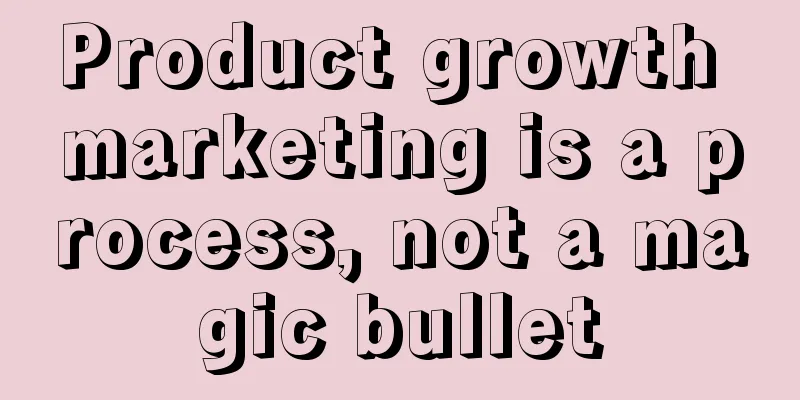How do UI designers analyze products correctly? Check out this comprehensive introductory guide!

|
Many people think that product analysis is the job of a product manager, but in fact, UI designers also need to use product analysis skills to handle daily work and improve the quality of their output. Product analysis is actually not as mysterious as imagined. This article will teach you how to complete product analysis through the correct steps. What is Product Analysis Product analysis, as the name suggests, is to conduct a systematic and multi-dimensional analysis of an Internet product, and ultimately complete a business report with clear logic and in line with objective facts. Why do we need this report? That's because for our work decisions, the more effective reference information we get, the more it can help us make the right choices.
For example, if I plan to make an APP for customized milk tea delivery, I need to understand what modules and functions such APP products usually have, what the ordering process is like through the APP, and what kind of design or interaction users prefer. At this time, it is useless to rely on my own imagination. I have to analyze peers or related food delivery APP products to get a clear conclusion, and then use it as a basis to start designing my own product. Sometimes, if we carefully analyze the other party's products before an interview or client negotiation, we can be in a more advantageous position during the communication process and have higher-quality communication and discussion. There are many benefits of product analysis. It can not only help us solve current problems, but also help designers exercise their logical thinking ability, product ability and business ability. It is an essential skill for promotion and salary increase. Goals of product analysis Next, many students may be eager to know how to start product analysis, but don’t worry, I will first talk about something that is overlooked by many people and not mentioned in many articles, which is the goal of product analysis. As mentioned above, product analysis must be presented in the form of a business report, and a qualified business report must provide a "clear conclusion". If the report is not clear in direction, and is written in a 100-page manner, with all the analysis content that can be listed in it, it will be a disaster for both the author and the readers, because such a report has no focus and lacks readability. Before we start the analysis, we need to determine a clear goal, that is, what information we want to obtain through this report. In terms of the content obtained, we often do not just want to get one result, it is likely to be plural, so we need to make a table to list them. For example, if we start from the idea of a milk tea delivery service app, we analyze the products of Meituan or Ele.me and set the following goals: It can be seen that the analysis of product and interaction levels is obviously more important than design. According to the MVP principle, the first version should be a product with a smooth process. Excessive attention to design and details in the early stage is not the primary task. Therefore, the focus of product analysis will be different in different scenarios, periods, and strategies, and the time left for us to analyze will not be sufficient. Therefore, we must focus on the most important things and improve efficiency in order to truly solve the problem. Contents of product analysis The content of the entire product analysis can be divided into multiple dimensions and several details, which I express using the mind map below. Such a chart is daunting. If we analyze each part carefully, we will have to write a lot of content. That’s why we have the goal of planning analysis as mentioned above. In the actual implementation process, there are many analysis items that do not need to be mentioned. Furthermore, product analysis also includes branches such as competitor analysis, operation analysis, interaction analysis, visual analysis, and copywriting analysis. They each have their own focus and trade-offs, so don’t panic. Below, we briefly explain each of these contents. 1. Basic product information The first step in analyzing any product is to have a general understanding of it. The first step is to download and experience it, and be able to summarize its functions in one sentence, and then what kind of user needs are solved by this function. Next is the current status of the industry it is in, whether its scale has been increasing year by year, what are the heavyweight news or innovations, and what are the future development trends. If we don’t know, we can search more on Baidu, Zhihu, and news portals, and collect as many reliable data reports or charts as possible to facilitate information collation. For some newly launched applications, they usually have very obvious start-up team imprints and may have some unimaginable interactions or functions. At this time, it is useless to waste time thinking about the application. You can spend some time looking for the resumes of the founding members online, which will be more helpful for us to understand the application. For example, the founder of Pinduoduo had accumulated many years of experience in "Pinhaohuo" before going online. The product model is a tested product with a lot of similar features. ***, we can also collect simple information about the current situation of the product, whether there is strong external competition, their respective market share data, and user evaluations of the product in different stores and social platforms. This can help us have a preliminary understanding of the competitiveness and reputation of the product. 2. User Research The term user research appears very frequently. It is an essential project preparation for professional product teams. There are many ways and outputs of user research. Usually, we will establish a clear target portrait to find the target users, then interview and survey them, design usability tests, eye movement tests, etc., to help us better launch products that users will like. But when we study external products, we often don’t need to think about it too complicatedly (unless we are analyzing direct competitors), otherwise we only need to organize the target user portrait of the product. User portrait summarizes the characteristics of core users in multiple dimensions and is mainly divided into three parts.
Physiological characteristics mainly include the user's age, gender, height or weight, while external characteristics include content that can be directly collected, such as education, work experience, city, salary status, etc. Internal characteristics include personality, hobbies, behavior (prefer women's clothing), etc. and related subjective characteristics. By filtering these attributes according to our needs, we can create several standard user portrait cards, such as the one below. 3. User experience elements Because the demand for professional analysis of products, experiences, and designs has increased significantly in the past two years, the five elements in “Elements of User Experience” have become a frequently used analysis model. It provides us with clear analysis steps and directions and is easy to use. Strategic Layer The strategic level refers to the macro and commercial considerations of the product, which requires our own judgment, because if you are not an internal staff, then the strategic thinking of a product cannot be absolutely accurate. Although you can search for a lot of business analysis and corporate PR drafts on the Internet, the use of these contents is often deceptive and is a smokescreen for the public based on operational needs. Therefore, if you are not confident enough in the report, don't talk about this issue at length. You just need to answer what kind of product can meet the needs of users and achieve commercial success. Range layer The information available at the strategic level is usually a relatively macro and vague concept, so we need to develop more specific plans, clarify what functions and services the product should include, and plan the scope of product functions to be covered. For example, for an APP that provides milk tea delivery service, our initial functions include selecting store products, adding to shopping carts, and transaction settlement systems, but do not include functions such as information push and order sharing communities. Therefore, the scope layer is to list the most important services and product contents provided by the product. Structural Layer This is the function or information structure of a product, which can usually be sorted out using a mind map or tree diagram. The most basic method is to sort out the page hierarchy of the product by sorting out the hierarchy of the visible pages. A better way is to create a product flow chart based on several core functions of the product to show the structure and logic of the operation. The process of drawing this chart can better deepen our understanding of the product. Framework layer The framework layer refers to the layout structure of the page, as well as the interaction and display at the component level. Generally speaking, you can study the main process pages of the product, whether the layout and information display of each page are reasonable, and whether the operation is smooth. If you feel that you cannot understand it well, the book suggests that you approach it from three angles: "interface design", "navigation design" and "information design", but this is too difficult to operate. It is recommended that when analyzing this interface, you only need to pay attention to whether the layout of the content from top to bottom fits the theme, and whether the field weights in important components can be well expressed. For example, let's look at the flight page of Alitrip below. The page modules are city, date, flight list, and sorting filter. In the flight list, the price information that users pay most attention to is highlighted (proving that users who buy air tickets are more sensitive to price), and time as a secondary weight element is relatively weakened, but still easy to identify. Presentation Layer Here we focus on analyzing the characteristics of the product design itself, which is relatively easy. We only need to analyze the color scheme, the consistency of the design, and capture the details of the motion effects and emotional design. The analysis of the five elements of user experience is not a random throwout. If the analysis is done according to the original book's method, it will definitely produce a very complicated report, so I will refine the idea of user experience analysis again. By analyzing the business goals of the product, we can start to divide the functions and services, and then summarize the main operation processes based on the core services, and judge whether they are beneficial to the core processes and can be accepted by users in terms of interaction, layout, and design. Then we can conclude that if they are beneficial, then the product meets the conditions of the business goals, and if not, it will be difficult to achieve. 4. Profit model Some products have purchase elements or paid items, so it is very important to analyze them. Because the ultimate goal of any commercial product is to make a profit, most products will work hard in this regard. If it is an application type where transactions occur directly, such as e-commerce, food delivery, and express delivery, it is relatively intuitive to analyze the communication process of the product itself. If it is an application similar to social, information, or tools, the profit point is often more obscure, and usually contains more scattered sources of profit, such as advertising space in different locations, subscription services, paid props, etc. All we have to do is list all these profit sources and fill in the corresponding prices if we know them. 5. Operational Strategy If it is not a tool-oriented product, it usually has heavy daily operations, including user operations, community operations, media operations, content operations, and event operations. The iterations of many products are operation-oriented. We often cannot get ideal results by directly analyzing the product functions themselves, so we need to approach it from an operational perspective. For example, if you carefully study the services of a fresh food e-commerce company like MissFresh, you will find that the transaction process of this product itself is unremarkable, but its highlight lies in its endless operational strategies, whether it is content operation in product selection or event operation. These operational methods are the main factors driving product changes and optimizations. Summarize At this point, we have introduced almost everything we can do to analyze a product. No analysis framework can meet all requirements, so we need to be flexible after clarifying the information we want to obtain, select the content that needs to be analyzed, and then start. As long as we master this idea, we can calmly deal with any product analysis requirements. |
>>: Did the user quit the app as soon as he opened it? Use these 4 methods to keep him here!
Recommend
27-year-old female host died suddenly after infusion! The "silent killer" is this... commonly used in respiratory department!
Expert of this article: Liu Zhijun, Pharmacy Depa...
Why is the Honor 9X series so priced so brutally?
On July 23, Honor released the new Honor 9X serie...
The Shenzhou 14 astronauts are back home! Do you know how many difficulties the astronauts have to overcome to get home?
China Science and Technology News Network, Decemb...
Digium Open Source Real-Time Audio and Video Communications SDKs
[[146898]] Digium, creator of the WebRTC platform...
This gene allows cells to “reborn with memories”!
If you were asked to be reborn in childhood with ...
Zhu Jiang, Vice President of Jidu Auto, resigned less than half a year after joining the company
At noon on June 7, Sina Technology exclusively le...
What mysteries does "Schrödinger's Cat", one of the four great beasts of physics, contain?
Produced by: Science Popularization China Author:...
Will you get cold legs if you go out without wearing long underwear? The answer from doctors at West China Hospital is...
Two days ago, I was still bathed in the warm wint...
Although selling new energy vehicles is not profitable, Honda still plans to invest 3 billion to expand its Chinese factory in order to "catch up"
According to Japanese media reports, GAC Honda ha...
How can newbies quickly become familiar with WeChat public account operations?
This article discusses four major aspects: famili...
It's all tap water, why do foreigners drink it directly?
Review expert: Wang Guoyi, Postdoctoral Fellow in...
"Mysterious Eastern Power" Impacts US Stocks! What is DeepSeek that everyone is talking about?
On January 27, local time, the Nasdaq stock index...
Android MVP framework learning and practice
Preface I thought that Internet companies basical...
BAIC BluePark's revenue in the first three quarters increased by 63% year-on-year, and sales increased by 91%
On October 27, BAIC BluePark (SH.600733) released...
How did people determine body temperature before thermometers were invented?
Humans have been looking for ways to measure temp...









